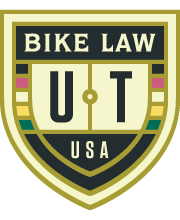It’s important to know your legal rights (and duties) when bicycling in Utah. It is especially important after a bicycle accident (we call them bicycle “crashes” and explain why here).
For any questions about Utah’s bike laws, or about your rights to the road, contact attorney Ann Groninger directly.
General Rights and Duties
- Utah bicyclists generally have the same rights and duties as drivers of motor vehicles
- Bicyclists must ride in a reasonably careful manner so as to not collide with a pedestrian or another bicyclist
Rights and Duties of Bicyclists on Sidewalks, Paths, Trails, and Crosswalks
- Bicyclists under 18 have an absolute right to use a sidewalk, path, trail or crosswalk; bicyclists 18 and over may be prohibited by traffic device or ordinance
- Must ride at a speed that is reasonable under the circumstances
- Yield the right of way to pedestrians
- Are not required to use bike lanes or paths unless specifically directed to do so
- Otherwise have all the rights and duties of a pedestrian when using a sidewalk, path, trail or crosswalk
Prohibitions
- Carrying more passengers than the number for which the bicycle is equipped
- Unsanctioned racing on public roadways
- Carrying anything that prevents the bicyclist from having both hands on the handlebars
- Not having at least one hand on the handlebars at all times
- Using a siren or whistle while riding a bicycle
Helmets
- Utah has no helmet requirement for bicyclists, regardless of age
Alcohol
- Utah’s drinking and driving law does NOT apply to bicyclists (except class 2 e-bikes)
- Local ordinances may impact impaired cyclists
Where to Ride
- Bicyclists must travel in the direction of traffic
- Bicyclists riding slower than the speed of traffic must ride as near as practicable to the right-hand edge of the roadway unless:
- passing another vehicle going in the same direction;
- preparing to make a left turn
- traveling straight through an intersection that has a right-turn only lane
- when it is reasonably necessary to avoid conditions that make it unsafe to ride to the far right, such as:
- fixed or moving objects such as other vehicles, pedestrians and animals;
- surface hazards; or
- a lane that is too narrow for a bicycle and a vehicle to travel safely side by side within the lane.
Left Turns
Left turning bicyclists May:
- Following the same rules applicable to motor vehicles turning left OR
- proceeding through the intersection as close to the curb or right edge as practicable, stopping at the far end of the intersection; then, yielding to traffic in all proceed in the new direction
Left turning bicyclists MUST:
- obey all traffic control devices directing bicycle
Stop Signs and Traffic Control Devices
- In general must obey all traffic control devices
- Must come to a full and complete stop at all red lights
- May treat a stop sign as a yield sign, as long as the rider slows, yields to traffic in the intersection and with the right of way and yields to pedestrians in the intersection and adjacent crosswalks
- A bicyclist who is over 16 years old and who cannot trip a traffic signal may proceed with caution after waiting at least 90 seconds and then ensuring that the way is clear
Signaling
- Bicyclists must use hand/arm signals when turning and stopping
- A bicyclist is not required to continuously signal if the bicyclist’s hand is needed to control the bicycle
Group Riding
- May not ride more than two abreast except on paths or parts of roadways set aside exclusively for bicycles
- Bicyclists riding two abreast may not impede the normal and reasonable movement of traffic and shall ride within a single lane
Required Equipment
- A brake that enables stopping within 25 feet from a speed of 10 miles per hour on dry, level, clean pavement
- From a half hour after sunset to a half hour before sunrise and at other times with not enough lighting to see more than 1000 feet, must have a front white light, rear red light or reflector and side reflectors visible from 500 feet
Electric Assist Bikes
- Are divided into three classifications:
- Provides assistance up to 20 mph and only when the rider is pedaling;
- Provides assistance up to 20 mph with or without the rider pedaling;
- Provides assistance up to 28 mph, only when the rider is pedaling, and has a speedometer
- E-bicyclists are subject to the same laws as bicyclists unless otherwise provided
- Local authorities may regulate their use on sidewalks, paths or trails
- Children under 16 may not operate a class 3 e-bike
- Children under 14 may not operate an e-bike on public property without adult supervision
- Children under 8 may not operate an e-bike on any public property
- Utah based manufacturers and distributors of e-bikes in Utah must label e-bikes with the appropriate Utah classification, top speed and wattage
Permitted Bicycle Parking
- on sidewalks as long as they don’t impede pedestrian and other traffic
- in any location where parking of vehicles is allowed
- according to Utah laws regulating vehicle parking
Stopping Bicyclists
- law enforcement officers who have reasonable cause to believe a bicycle is not equipped as required by law or is not in proper repair may stop the bicyclist to inspect the bicycle
Drivers Overtaking Bicyclists
- Motor vehicle drivers may not operate a motor vehicle within 3 feet of a bicyclist
- A motorist may cross the center line to pass a bicyclist if the movement can be done safely
- A motorist may not attempt to distract a bicyclist for the purpose of injuring or forcing the bicyclist off the roadway
Motor Vehicle Doors
- No person may open the door of a motor vehicle unless it is safe to do so.
